Birds come in all shapes and sizes. Some birds evolved long wings to help them fly over great distances, while others developed short, powerful wings. Meanwhile, some birds possess long beaks to help them catch fish, while others have short beaks to break open seeds. Depending on their environment, birds can rely on a different set of physical abilities in order to survive. For example, most mammals have 7 cervical vertebrae in the neck. Therefore, most mammals possess rather short necks, which helps to reduce birth complications and neuronal problems. However, reptiles, amphibians, and birds adapted to have varying numbers of vertebrae in their necks. This is why you see some birds with short necks and other birds with long necks. Birds with long necks rely on their necks to help them catch prey and usually belong to the wading class of birds. That said, which birds have long necks?
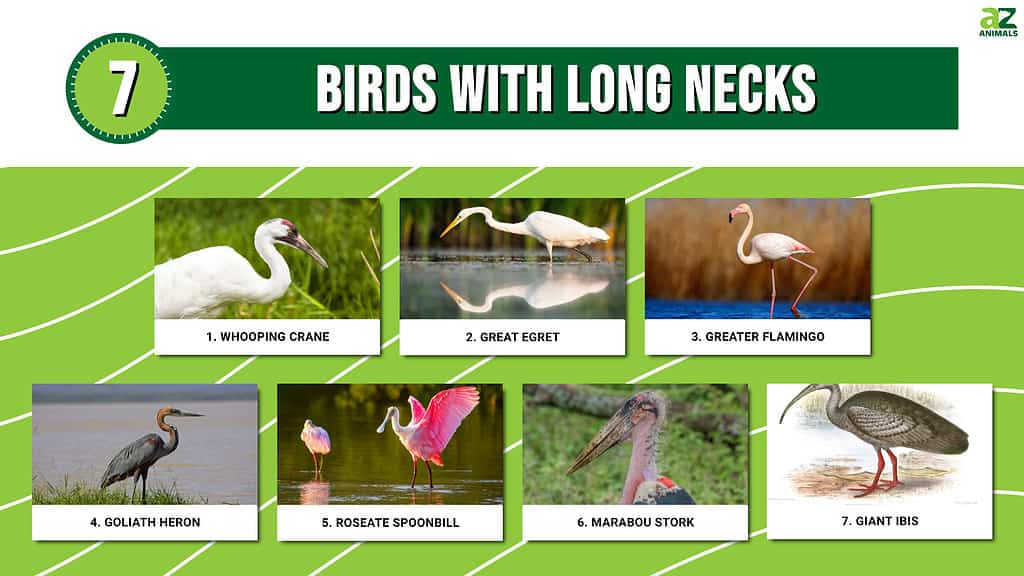
In this article, we’ll cover 7 different birds with long necks. Along with discussing their distribution and habitat, we’ll also discuss their physical characteristics, diet, and conservation status. Furthermore, we’ll take the time to examine the structure of their necks and how they use their long necks to survive. Get ready to stretch out your neck and pay attention as we learn about 7 birds with long necks.
#7: Giant Ibis
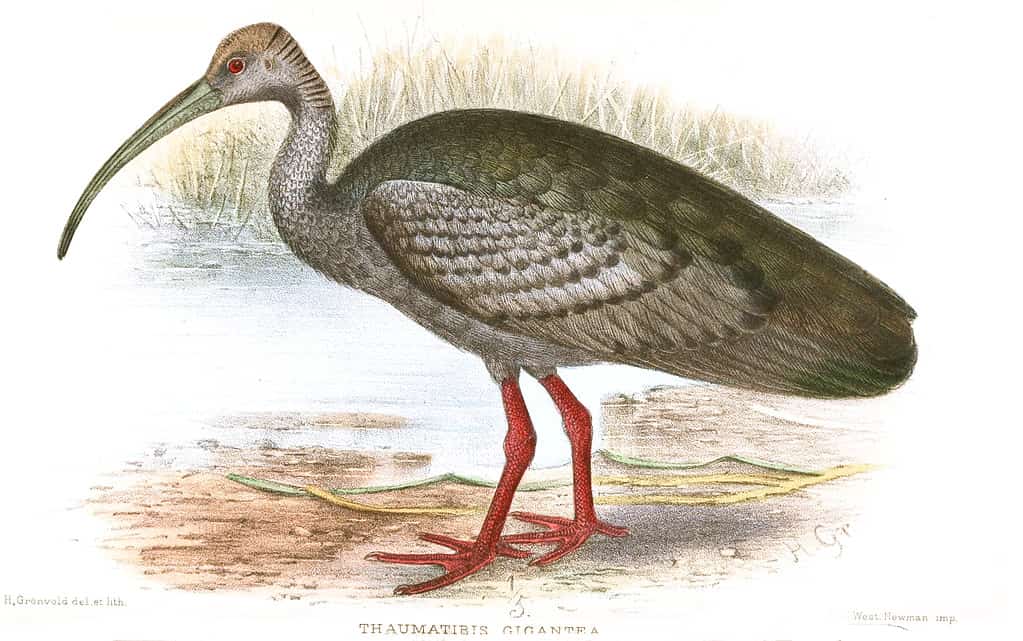
Due to habitat loss and climate change, the IUCN lists the giant ibis as Critically Endangered.
©Henrik Grønvold, Public domain, via Wikimedia Commons – License
The giant ibis is a member of the ibis and spoonbill family Threskiornithidae. It is the largest extant ibis in the world and the only member of its genus Thaumatibis. You can only find these large wading birds in parts of Cambodia, Laos, and Vietnam. Their preferred habitat includes wetlands areas such as marshes, lakes, rivers, ponds, and some open meadows. On average, they measure 40 to 41.5 inches long and weigh around 9.3 pounds. They feature dark gray-brown plumage, with darker bands across the head and shoulders and silver wingtips. The neck of a giant ibis is quite long and curves backward before jutting forward. They use their long neck to help them catch aquatic invertebrates, crustaceans, amphibians, reptiles, and insects such as mole crickets. At this time, due to habitat loss and climate change, the IUCN lists the giant ibis as Critically Endangered.
#6: Marabou Stork
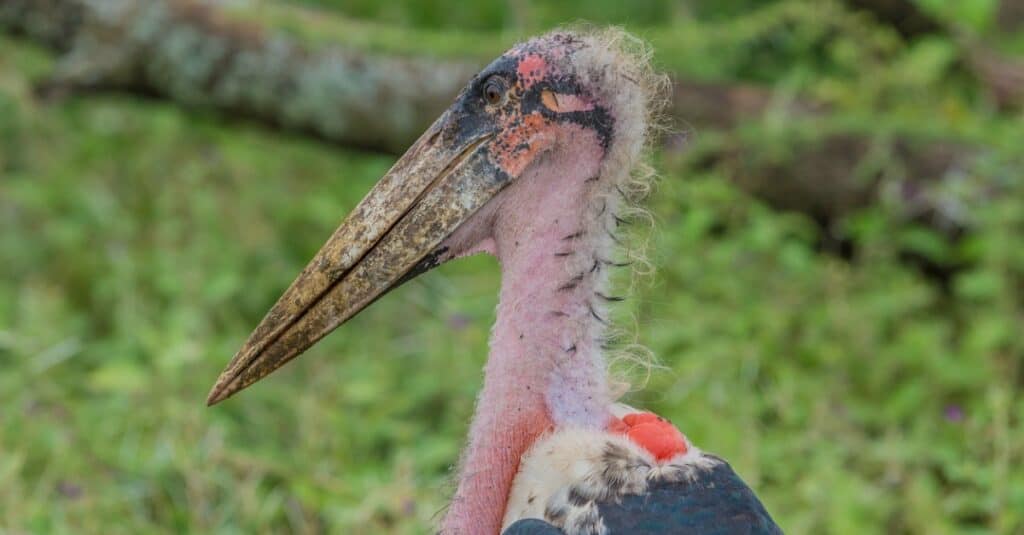
The marabou stork’s long neck lacks feathers, which helps it keep clean while scavenging for carrion.
©iStock.com/Gerald Corsi
Also known as the undertaker bird, the marabou stork is a member of the stork family Ciconiidae. It gets its nickname from its appearance, which includes large, cloak-like gray-black wings. The marabou stork also sports long, thin legs, a white patch of hair on its back, and a bald head and neck. Typically, they stand 60 inches tall, weigh nearly 20 pounds, and feature a wingspan between 7 to 13.3 feet. They live only in Africa south of the Sahara Desert and thrive in both wet and dry habitats. Marabou storks live in colonies but frequently exhibit aggressive tendencies. Their diet mainly consists of carrion, which likely explains why their head and neck both lack feathers. No feathers ensure that these birds with long necks keep their bodies clean while digging around in the bodies of corpses. The IUCN lists them as a species of Least Concern.
#5: Roseate Spoonbill
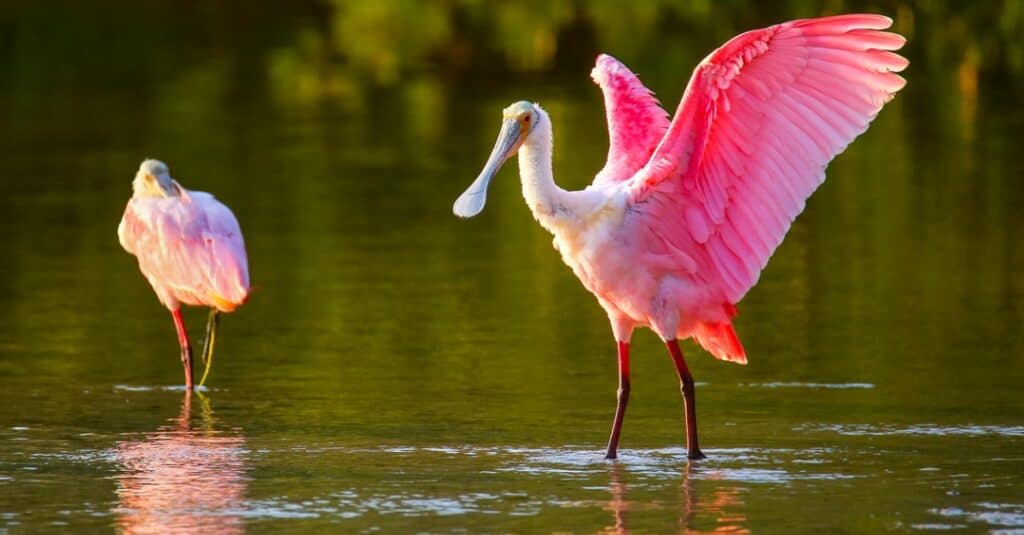
The roseate spoonbill uses its long neck to help it find crustaceans in shallow water.
©iStock.com/Donyanedomam
Like the great ibis, the roseate spoonbill is a member of the stork and ibis family Threskiornithidae. They live in both freshwater and coastal regions of the southeast United States, Mexico, Caribbean, and Central and South America. On average, they measure 28 to 34 inches long and weigh between 2.6 to 4 pounds. The roseate spoonbill gets its name from its reddish-pink color and large, flat bill. Aside from their primary bright plumage, they feature white feathers on their long neck, back, and breast. Similar to flamingos, their color comes from their heavy diet of crustaceans, although they also eat insects, frogs, and newts. Roseate spoonbills use their long necks to help them search for food in shallow water. Despite predation from predators and other threats, the IUCN lists the roseate spoonbill as a species of Least Concern.
#4: Goliath Heron

The goliath heron is the largest extant heron and sports an incredibly long neck to boot.
©iStock.com/slowmotiongli
Also known as the giant heron, the goliath heron is a member of the heron family Ardeidae. Generally, goliath herons measure 3 feet, 11 inches to 5 feet long, and weigh between 8.8 to 11 pounds. Overall, their color is predominantly light brown and gray. However, unlike the rest of its body, the throat, foreneck, and upper chest all appear white with black streaks. They live almost exclusively near water such as lakes, marshes, and deltas, and even avoid flying over land whenever possible. You can find them mostly in Sub-Saharan Africa, although some also live in South Asia. Their diet, mainly consists of fish such as mullet, tilapia, and carp, although they’ll eat almost whatever they can catch. They use their incredibly long necks to help them catch this wide variety of prey. The IUCN lists these birds with long necks as a species of Least Concern.
#3: Greater Flamingo

The greater flamingo is the largest member of the flamingo family and features an incredibly long neck.
©Ondrej Prosicky/Shutterstock.com
The greater flamingo is part of the flamingo family Phoenicopteridae. Of all extant flamingo species, the greater flamingo is both the largest and most widespread. You can find them throughout mudflats and shallow coastal lagoons in Africa, Southern Europe, and South Asia. By and large, most greater flamingos measure 43 to 59 inches tall and weigh from 4.4 to 8.8 pounds. Their plumage looks predominantly pink, although the edges of the wings appear redder. Like all flamingos, they get their color from the massive amount of shrimp that make up the bulk of their diet. However, they also eat seeds, algae, and mollusks. While feeding, these birds with long necks will suck water through their bills and then filter out any foodstuffs. Due to their widespread distribution, the greater flamingo is listed as a species of Least Concern by the IUCN.
#2: Great Egret
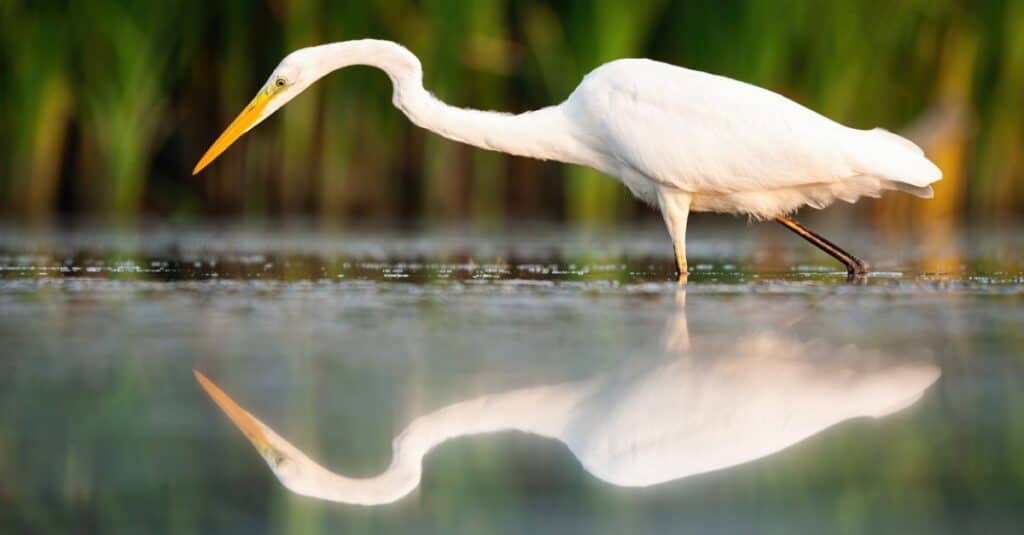
The great
egret
walks with its long neck outstretched as it hunts for food.
©WildMedia/Shutterstock.com
Also known as the common egret or great white egret, the great egret is part of the heron family Ardeidae. The great egret ranges throughout various wet and dry habitats in Europe, Asia, Africa, and North and South America. Its Latin name, Ardea alba, translates to “white heron,” which is an apt moniker. Aside from its black legs and feet and yellow bill, the great egret appears almost completely white. Generally, they measure 31 to 41 inches long with a wingspan between 52 to 67 inches. Their diet primarily consists of fish, but also includes insects, frogs, reptiles, and small mammals. While flying, you will usually see a great egret with its neck retracted. However, when not flying, these birds with long necks tend to walk with their necks outstretched. Thanks to their abundance, the IUCN lists the great egret as a species of Least Concern.
#1: Whooping Crane
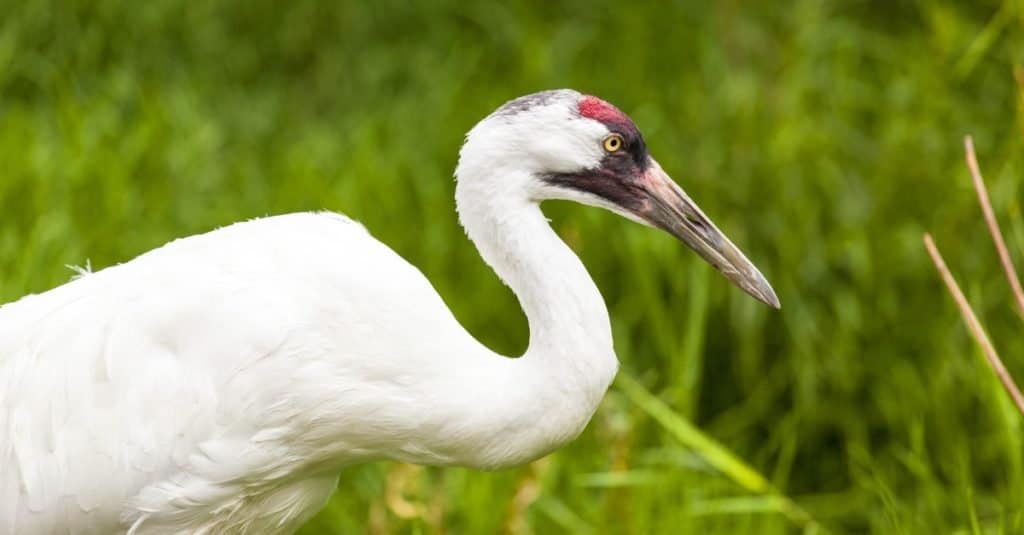
The whooping is one of the most rare birds with long necks, with a total population of around 800 birds.
©GTS Productions/Shutterstock.com
The whooping crane is a member of the crane family Gruidae. Its name derives from its unique vocalizations, which can be heard from over a mile away. They only live in North America and range from Canada in the north to the Gulf of Mexico in the south. In fact, they rank as the tallest birds in North America, as they stand between 4 feet, 1 inch to 5 feet, 3 inches tall. Their plumage appears predominantly white, although they possess a red crown and black wingtips. Compared to some other birds with long necks, the whooping crane’s neck is relatively straight. They use their long necks to help them catch crustaceans, mollusks, and fish while wading through shallow water. Due to habitat loss and overhunting, the current population of whooping cranes is only around 800 birds. As a result, the IUCN lists the whooping crane as an Endangered species.
Summary Of The 7 Birds With Long Necks
| Rank | Long-necked Bird |
|---|---|
| 1 | Whooping Crane |
| 2 | Great Egret |
| 3 | Greater Flamingo |
| 4 | Goliath Heron |
| 5 | Roseate Spoonbill |
| 6 | Marabou Stork |
| 7 | Giant Ibis |
The photo featured at the top of this post is © William Cushman/Shutterstock.com
Thank you for reading! Have some feedback for us? Contact the AZ Animals editorial team.






